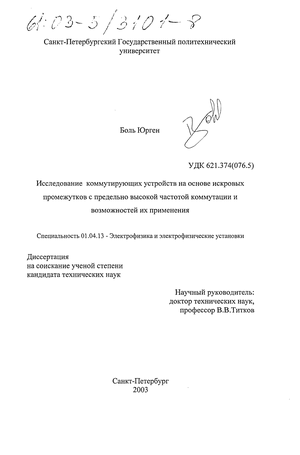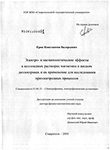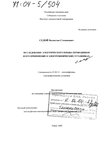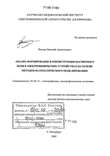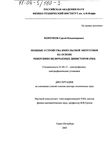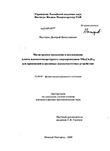Содержание к диссертации
Введение
1 Introduction 8
1.1 Status of Technology 9
1.2 Phenomenological Observations and Delimitation of the Work 12
1.3 New Aspects of the Work 13
1.4 Objectives 13
2 Literature 14
2.1 Pulsed Power Technology 14
2.1.1 General Applications 14
2.1.2 Spark Gap Operation 15
2.1.3 General Static Spark Gap Analysis 17
2.2 High Voltage Switches for Pulsed Power Applications 20
2.2.1 Vacuum and Gas Filled Switches 20
2.2.1.1 Spark Gap 20
2.2.1.2 Cold Cathode Switching Tube 22
2.2.1.3 Krytron 23
2.2.1.4 Sprytron 24
2.2.1.5 Thyratron 25
2.2.1.6 Ignitron 26
2.2.1.7 Vacuum Discharge 26
2.2.2 Solid State Devices 27
2.2.2.1 Thyristor 27
2.2.2.2 GTO-Thyristor 28
2.2.2.3 MOSFET 29
2.2.2.4 Insulated Gate Bipolar Transistor (IGBET) 29
2.2.2.5 Photo-Conductive Switches 31
2.2.2.6 Advantages and Disadvantages of Semiconductor Switches 31
2.3 High Power Generators - Transmission Line Generators 32
2.3.1 Blumlein Generator 32
2.3.2 Self-Matched Transmission Line Generators 33
2.3.3 Pulse Forming Network (PFN) Marx Generators 34
2.4 Spark Gap Applications in Various Technologies 35
2.4.1 Transmitter Technology 35
2.4.2 Radar Technology 37
2.5 Conclusion 40
3 Electrical Model of the Fast Switching Device 41
3.1 Time Dependent Resistance of the Spark Gap 41
3.2 Modelling with Constant Current Source 49
3.3 Modelling with Constant Voltage Source and Charging Resistor 54
3.4 Cascading of several Fast Switching Devices 57
3.5 Discussion of Numerical Simulation Results 61
4 Experimental Investigations 65
4.1 Test Set for Electrical Investigations 65
4.2 Macroscopic Experimental Investigations 71
4.2.1 Objectives 71
4.2.2 Test Matrix 71
4.2.3 Characteristic Macroscopic Electrical Test Results 73
4.2.4 Test Parameter Dependencies 78
4.2.5 Electron Emission Mechanisms 81
4.2.6 Electro-Technical Model of PRR with two Modes Page 84
4.2.7 Physical Interpretation of the two PRR Modes 88
4.2.8 Conclusion 90
4.3 Microscopic Experimental Investigations 92
4.3.1 Objectives 92
4.3.2 Test Set for Optical Investigations 92
4.3.3 Test Matrix 95
4.3.4 Characteristic Microscopic Electrical Test Results 96
4.3.5 Characteristic Microscopic Optical Test Results 105
4.3.6 Test Parameter Dependencies 107
4.3.7 Conclusion 108
4.4 Conclusions of Experimental Test Results 109
5 Comparison between Modelling and Experimental Investigation Results 111
6 Summary 119
7 Outlook 124
7.1 Further Investigations 124
7.2 Theoretical and Practical Applications 125
8 References 128
Annex 133
- Phenomenological Observations and Delimitation of the Work
- Advantages and Disadvantages of Semiconductor Switches
- Modelling with Constant Voltage Source and Charging Resistor
- Characteristic Microscopic Electrical Test Results
Введение к работе
Emission and generation of electromagnetic fields are in the focus of interest since Marconi first proved the emission of electromagnetic fields according to the theoretical work of Hertz [1]. From this origin the intention of transmitting and receiving terrestrial information rose dramatically, establishing a huge economical important market of wireless communication. Nowadays, living standard is dominated by cellular phones, commercial radio and TV, wireless observation, telemetry systems, GPS, and satellite connection.
The EMC aspects are in the meantime very well defined. All kind of electronic devices have to be qualified with respect to electromagnetic emissions. The EMC test houses and also the companies which are developing and producing electronic devices are equipped with "standard" EMC test equipment.
Nevertheless, the common electromagnetic smog and the latest developed and fielded High Power Microwave (HPM) narrow band radiating sources on the basis of accelerated electrons (electron beam devices) as well as the upcoming Ultra Wide Band (UWB) devises leads to an extent of further test capabilities which have to cover the additional electromagnetic pulsed frequency spectrum (between 100MHz and 3GHz), power density, pulse shape, and the pulse repetition rate.
The focus of this work is on the investigation of spark gaps with respect of an operation mode not for the classical high current (several tenth of kA) and high voltages (several tenth of kV) where the switching rate is limited but on the possible (limitation) achievable switching rates at low current (mA) and low voltage ( 2 kV). If is possible to realise stable and robust switching operations at reasonable very high switching rates (several tenth of kHz), there would be the change to generate at least electromagnetic test systems operating in the ultra wide band range depending on the physical achievable switching rate and the achievable switching velocity of a spark gap configuration itself. Such spark gap configurations could lead to a low cost ultra wide band test source in comparison to the conventional, more or less off the shelf available ultra wide band test sources which are designed and constructed on the basis of semiconductor switches. Such ultra wide band test sources are necessary to verify the functionality of communication devices in a rough electromagnetic environment. These rough electromagnetic environments will be specified in the near future. Further future applications could also be seen in the data communication scene and others.
1.1 Status of Technology
In any situation where communication (wireless as well as wired one) is used the systems have to work properly also "undefined, electromagnetic rough" environment where suppression of the own communication capability has to be ensured. Since world war two an intense afford to jam any kind of wireless communication and sensor signals is taken and known as jamming [2]. Starting with CW-jammers more and more complicated and efficient robust modulation schemes were introduced to face this threat [3]. Today a wide range of counter measure and counter-counter-measure technology is available not only in the communication field but also in jamming radar and if-sensors in intelligent systems. With further development of radar system technology and rising power levels electron beam devices like magnetrons, reltrons or cyclotrons gained so much power that their radiated pulsed power up to the gigawatt region caused electronic failure to exposed electronics [4]. Therefore, these sources were optimised to kill electronics in a far distance. According to their pulsed mono-frequent waveform and their peak power in the megawatt region these sources are covered under the name of HPM (high power microwave) [5].
The last ten years very short pulses with a rise time of some hundred picoseconds and peak power above 1 GW were detected as effective against some class of electronic devices [6]. These sources are summarised under the name of UWB (ultra wide band).
The kind of electronic device and field coupling, the source power, pulse repetition rate, pulse width, the applied frequency and the kind of intended effect (electronic burn out, reset, distortion) define the actual working distance [7]. Usually the main difference of the type of coupling is front door, or back door coupling. Interference of a nominal sensor or communication signal is intended in the front door coupling case. Here, the interference frequency is equal to the nominal signal frequency and both couple through the nominal antenna to the system. The interference signal has to be a modulated continuous wave (CW) or with a high repetition rate pulsed signal. The actual field level of this interference signals is quite low due to the fact , that the automated gain control of the input stage will be brought into saturation where no longer a discrimination between working signal and interference signal can be realised [8].
In the back door coupling case the external field couples through holes and parasitic antennas inside the housing of an electronic system and travels along wires to the electronic components. The frequencies are therefore tuned to structure resonances. In the disruption case the high frequency components (typically in the lower gigahertz region) are rectified to DC and pulses or demodulated to their low modulation frequency due to the non-linearity of the semiconductors. This low frequency distortion superimposes to the nominal signal. When UWB or HPM-pulses are applied, the rectified pulses may cause temporary digital circuit failure, latch-up or burn out in the semiconductor [9].
Certain classes of electronic systems are only susceptible to high repetition frequencies above 1 MHz [10]. In the front door case the fast recovery time of the automatic gain control circuits are responsible. In the back door case the hit probability of the susceptible fast clock transition time slot rises with higher repetition rate.
HPM sources rely on the interaction between an electron-beam and the electromagnetic field where energy is transformed from the beam to the field. Their power supply consists of a switched pulse-forming-line [4]. The switch itself consists of a spark-gap which allows a PRR of usually only some hundred Hertz. The same disadvantage show spark-gap switched UWB sources [11]. Semiconductor switches are not usable for HPM sources because of the huge energy (kilojoules) and high voltages (some hundred kilovolt) to be switched. In the UWB source the energy is much smaller (joules) however the semiconductor switches have to be stacked to arrays, which makes such switches extremely expensive. Also reliability aspects of these switches are not solved [12].
Typical jammer systems are based on semiconductor switches [2]. All the power and energy is transferred in a small bandwidth or carrier frequency. For an effective operation, first the target has to be identified. Then the main beam of the high gain antenna is directed towards the target. The frequency is either adapted to the reconnaissanced target frequency or is swept around an estimated frequency range. This devices are expensive and have to be multiplied if a wide frequency spectrum has to be covered.
In many "test" applications a low cost, easy to handle, high repetition pulse test source is desirable. This work investigates some concepts capable to fulfil such a potential requirement.
Therefore, further investigations with respect to the potential application of spark gaps as "fast" closing switches is appropriate. Especially the robustness and the costs of spark gaps usage compared to semiconductor switches is an important factor.
Where are the physical limits of the pulse repetition rate?
What does it mean for potential applications compared to conventional semiconductor switch applications?
1.2 Phenomenological Observations and Delimitation of the Work
Common switches based on spark gap technology show fast switching times in the nanosecond or even in the sub-nanosecond regime. But the recovery time of those switches is located in the millisecond regime. This is the reason why typical repetition rates of only a few hundred Hertz are possible.
Especially for quasi unsynchronised oscillating applications where the electromagnetic compatibility is critical and semiconductor applications are not possible, very fast pulse repetition rates achieved with spark gaps could be useful.
In the literature the stabilisation of very high repetition rates of spark gaps could not be found. Due to the switching time in the microsecond regime the electrical characteristics of the designed and parasitic inductances and capacities are of special interest. It is observed that these elements also influence the fast switching off behaviour of the spark gap arrangement. The coupling of electrical components and physical charge and discharge effects will be considered.
1.3 New Aspects of the Work
New aspects of the investigation of spark gap switches on the basis of the observed behaviour at low switching current (mA) and voltage ( 2kV) are:
Recovery time of some microseconds
Free oscillating (unsynchronised) spark gap configuration with several hundreds of kilohertz switching events
Compared to "Trichel Applications" the spark gaps are not voltage driven but current driven
Stabilisation and synchronisation of the repetition rates due to external electrical circuits
1.4 Objectives
The following major objectives are considered within the investigations of the spark gap configuration operating at lower power and energy but with higher switching rates per time:
Literature research
Electrical modelling of a simplified spark gap configuration and determination of the physical limitations and parameter dependencies to achieve high switching rates per time
Experimental investigations to consider the macroscopic and microscopic switching behaviour of the spark gap configuration and describing of the physical characteristics of the switching behaviour
Comparison of the experimental test results with modelling
Such high repetitive spark gap closing switches based on free oscillating (notriggered system) can be used for a wide range of applications -especially where semiconductor systems are too expensive, or where the electromagnetic compatibility is critical, or where electromagnetic fields would destroy semiconductor systems.
Phenomenological Observations and Delimitation of the Work
In any situation where communication (wireless as well as wired one) is used the systems have to work properly also "undefined, electromagnetic rough" environment where suppression of the own communication capability has to be ensured. Since world war two an intense afford to jam any kind of wireless communication and sensor signals is taken and known as jamming [2]. Starting with CW-jammers more and more complicated and efficient robust modulation schemes were introduced to face this threat [3]. Today a wide range of counter measure and counter-counter-measure technology is available not only in the communication field but also in jamming radar and if-sensors in intelligent systems. With further development of radar system technology and rising power levels electron beam devices like magnetrons, reltrons or cyclotrons gained so much power that their radiated pulsed power up to the gigawatt region caused electronic failure to exposed electronics [4]. Therefore, these sources were optimised to kill electronics in a far distance. According to their pulsed mono-frequent waveform and their peak power in the megawatt region these sources are covered under the name of HPM (high power microwave) [5].
The last ten years very short pulses with a rise time of some hundred picoseconds and peak power above 1 GW were detected as effective against some class of electronic devices [6]. These sources are summarised under the name of UWB (ultra wide band).
The kind of electronic device and field coupling, the source power, pulse repetition rate, pulse width, the applied frequency and the kind of intended effect (electronic burn out, reset, distortion) define the actual working distance [7]. Usually the main difference of the type of coupling is front door, or back door coupling. Interference of a nominal sensor or communication signal is intended in the front door coupling case. Here, the interference frequency is equal to the nominal signal frequency and both couple through the nominal antenna to the system. The interference signal has to be a modulated continuous wave (CW) or with a high repetition rate pulsed signal. The actual field level of this interference signals is quite low due to the fact , that the automated gain control of the input stage will be brought into saturation where no longer a discrimination between working signal and interference signal can be realised [8].
In the back door coupling case the external field couples through holes and parasitic antennas inside the housing of an electronic system and travels along wires to the electronic components. The frequencies are therefore tuned to structure resonances. In the disruption case the high frequency components (typically in the lower gigahertz region) are rectified to DC and pulses or demodulated to their low modulation frequency due to the non-linearity of the semiconductors. This low frequency distortion superimposes to the nominal signal. When UWB or HPM-pulses are applied, the rectified pulses may cause temporary digital circuit failure, latch-up or burn out in the semiconductor [9]. Certain classes of electronic systems are only susceptible to high repetition frequencies above 1 MHz [10]. In the front door case the fast recovery time of the automatic gain control circuits are responsible. In the back door case the hit probability of the susceptible fast clock transition time slot rises with higher repetition rate. HPM sources rely on the interaction between an electron-beam and the electromagnetic field where energy is transformed from the beam to the field. Their power supply consists of a switched pulse-forming-line [4]. The switch itself consists of a spark-gap which allows a PRR of usually only some hundred Hertz. The same disadvantage show spark-gap switched UWB sources [11]. Semiconductor switches are not usable for HPM sources because of the huge energy (kilojoules) and high voltages (some hundred kilovolt) to be switched. In the UWB source the energy is much smaller (joules) however the semiconductor switches have to be stacked to arrays, which makes such switches extremely expensive. Also reliability aspects of these switches are not solved [12]. Typical jammer systems are based on semiconductor switches [2]. All the power and energy is transferred in a small bandwidth or carrier frequency. For an effective operation, first the target has to be identified. Then the main beam of the high gain antenna is directed towards the target. The frequency is either adapted to the reconnaissanced target frequency or is swept around an estimated frequency range. This devices are expensive and have to be multiplied if a wide frequency spectrum has to be covered. In many "test" applications a low cost, easy to handle, high repetition pulse test source is desirable. This work investigates some concepts capable to fulfil such a potential requirement. Therefore, further investigations with respect to the potential application of spark gaps as "fast" closing switches is appropriate. Especially the robustness and the costs of spark gaps usage compared to semiconductor switches is an important factor. Where are the physical limits of the pulse repetition rate? What does it mean for potential applications compared to conventional semiconductor switch applications?
Advantages and Disadvantages of Semiconductor Switches
The main feature of the investigated Fast Switching Device (FSD) is a plain-plain electrode configuration (spark gap) with a very small gap separation of some 100pm. This very low electrode distance in combination with atmospheric pressure results in a maximum hold-off voltage in the low kV range.
The switch set-up was operated in free running mode, which means that a voltage higher than maximum hold-off voltage was applied to the FSD in order to guarantee self break through by over-voltage. After switch recovery the voltage rises again till the next self-breakdown takes place, so that the time duration between two break through events is mainly given by the capacity and the power rating of the external power supply. The geometrical structure of the FSD is shown in Figure 4.1-1. Two cylindrical electrodes (about 5cm in length for each electrode) of stainless steel are integrated into a test fixture made of insulating ceramics. The electrodes are movable to vary the electrode gap distance. The electrode gap separation was adjusted by the use of a separation gauge to realise gap separations between 140pm and 400pm with a minimum resolution of 10pm. The anode surface area is slightly smaller than the cathode surface area to ensure a defined plane-plane spark gap configuration. The anode and cathode diameters are 0.52mm and 1.02mm respectively. The cathode is selected with the bigger diameter to realise in the experiments a more homogeneous electrical field especially at the edges than compared with two identical diameters for the anode and the cathode. Also is the heat transmission at the cathode improved with respect of avoiding overheating due to ion crashes onto the cathode.
A short coaxial cable with open end is joined across the two electrodes acting as a capacitive load of 18pF. The total capacitance at the junction including spark gap and stray capacities is about 26pF. The principle electrical circuit network of the FSD is shown in Figure 4.1-2. High voltage is applied across one end of the spark gap switch with a series resistance of 1MQ. The other end of the spark gap switch is grounded (GND). The coaxial cable which is connected parallel to the switch represents the capacitor С in the circuit. The voltage characteristics of the switch is determined by measurement between the points A and B.
A coaxial cable between the electrodes and adapted high voltage probe (Tektronix P6015, 75MHz) with a ratio of 1000:1 is used to measure the voltage characteristics of the FSD. The basic test set-up for experimental measurements of the voltage and current characteristics at the FSD is shown in Figure 4.1-3. A high voltage DC power supply unit +(Fug, Model HCN 140-20000) with voltage and current ranges of 0-20kV and 0-6mA respectively has been used. The system is operated in active current limiting mode to pre-set the average charging current of the load capacitor. An oscilloscope (Tektronix TDS 684, 1GHz bandwidth and 5 giga sample) has been used to determine the fast breakdown voltage and current rise time characteristics of the FDS. Furthermore, the long term behaviour considering several break downs are recorded. The experiment are conducted in air at atmospheric pressure and ambient conditions.
When an over-voltage is applied with respect to the voltage capability of the spark gap, break through across the switch (spark gap) takes place, the capacitor discharges and the switch, S, gets closed. The voltage across the spark gap switch falls down and conduction between the electrodes takes place. After switch recovery, when the plasma density within the spark gap decreases and the conductivity is reduced, the voltage across the gap increases again by charging the capacity represented by the coaxial cable (refer Figure 4.1-1).
The main feature of this test arrangement is the investigation of the fast recovery of the spark gap plasma and the physical parameters of the FSD circuitry to allow very high repetition rates. Therefore, the 1MQ charging resistor is in series between the high voltage power supply unit and the spark gap circuit. Also with current limiting of the supply its DC current will not allow the spark gap to recover fast enough without or with an too low series resistor. A dramatically lower repetition rate would be the consequence.
The voltage break through of the spark gap switch has been observed at the oscilloscope in free running mode. This means the triggering of the spark gap was only determined by over-voltage. Readings (approximately 50) for the pulse to pulse duration between two subsequent break downs have been noted directly from the oscilloscope. This time duration can be interpreted as the "repetition rate" of the spark gap switch. The repetition rate has been investigated for several spark gap separations and for various DC current settings at the power supply unit. The current settings started from very low values of 0.1mA up to the maximum possible current closed to DC sparks. The break through voltage, the repetition rate and DC-arc has also been investigated using this test set-up. The repetition rate seems not to be a stable function of above described pre-setting values of DC current and spark gap separation. Therefore, a series of several readings between subsequent breakdowns were required to get statistical data. The upper limit of operation was given by a DC-arc which shortcuts the spark gap without recovery.
Some typical images as screenshots were also captured and stored using the oscilloscope to show the partially unstable behaviour of the repetition rate. The statistical data of each set of parameters were processed with statistical software to get histograms of the measured repetition rates. The data analyses of the experimental test results which is described in the subsequent paragraph.
Modelling with Constant Voltage Source and Charging Resistor
The voltage which can be sustained without breakdown is called the hold off voltage. So the hold off voltage increases with increasing spark gap distance electrodes. The repetition rate of the breakdown voltage depends on the voltage rise time applied across the spark gap. As the distance of the spark gap increases, the hold off voltage also increases as we should expect. So the time taken for breakdown voltage of the switch also increases [43] with the distance and hence it leads to decrease of the repetition rate.
Pressure is also one of the criteria to decide the breakdown speed and hence the repetition rate of the spark gap switch. The breakdown of the spark gap switch has high pd values in the Paschen curve. So, the hold off voltage of the spark gap distance increases with increasing of pressure. Presently, the operation of the switch is carried only in atmospheric pressure.
High gas pressure and small gap spacing have the advantage of a shorter arc, which reduces inductance and resistance. Gas with a high density also increases heat capacity, increases the breakdown strength, improves turbulence, and would increase the statistical pulse repetition rate. The type of gas used also characterises the operation of the FSD. The Paschen curve is different for different types of gases. For instance, the breakdown voltage at one atmospheric is 12kV/cm for H2, 23kV/cm for air and for SF6, is 67kV/cm. The recovery time in a spark gap switch is also complex, and depends to some extent to gas composition and pressure. Gas with high molecular speed and thermal diffusion [44] allows the recovery time to be faster and hence influences the repetition rate of the switch. The experimental investigations has been conducted in air only. Load resistor and capacity of the switch, limits the repetition rate of the spark gap. Presently, a series load resistor of 1MQ and a coaxial cable with capacity of 26pF have been used for the switch operation. The spark gap plasma was also considered during the experiments also the physical behaviour of the discharge processes are very complicated and difficult to be explained in detail. Figure 4.2.5-1 shows the test set up under operation and where the spark gap plasma can be seen. The switching operation of the FSD stops and a DC-arc is generated if the spark gap distance at given feeding current oversteps a certain value, whereas the ratio of the spark gap distance to feeding current is not constant. This effect depends very much on the thermionic emission with the heating up of the cathode due to ion bombardments onto the cathode with the consequence that the electron density increases dramatically. The degree of ionisation increases with increasing temperature and is maximum if the electrical conducting channel is generated [27]. The emission of electrons can be devided principle into two main competing mechanisms:
The generated positive ions in the plasma are accelerated to the cathode surface. The maximum velocity of the ions reaches values in the area of a few hundreds of electronvolts (eV). The emission at the cathode surface is caused by the ionisation potential of the ion which deforms the potential barrier of the cathode surface. The width of the cathode potential barrier is dramatically reduced and therefore the tunnel probability is increased [53]. For a secondary electron emission the tunnelling of two electrons is required because the major process is the neutralisation of the ion. The secondary electron emission coefficient depends on the ionisation potential and the kinetic energy of the ion. Values of the emission coefficient are in the range of 0.001 to 0.1 which can be found in tables [52]. The ion bombardment heats up the cathode surface and requires a high forward voltage drop [54] (voltage between cathode and anode required to carry the switching current in the plasma).
This process is a summary of two sub-processes which can exist independently and also superpose ideally Emission of electrons at high cathode temperatures. This mechanism is well known as "Hot Cathodes" in tube technologies like thyratrons or microwave tubes. In the electron energy distribution in the solid (cathode) appear a small number of electrons with an individual higher energy as the surface potential barrier. This allows them to exceed the barrier leaving the solid and are now accelerated by an external field. Necessary temperatures depend on the "work function" (energy of the electron emission barrier) which is mostly higher than 5000K (mostly higher than the vaporisation temperature of metals).
Emission of electrons at high electric fields. At very high electric fields (109 to 1010 V/m) the width of the potential barrier becomes so small that tunnelling probability becomes so high that electrons are always emitted. Also the height of the barrier is reduced. At rough electrode surfaces this mechanism can start already at lower macroscopic field values (field enhancement factor at micro tips is about 10 to 100). Combination of Ы) and b2). The combination of Ы) and b2) is known as thermionic emission or field enhanced thermic emission. With this combination the necessary electric fields and cathode temperatures are significantly less than the above mentioned values for the single processes. These processes are described by the "Fowler-Nordheim" and "Richardson Dushman" formulars. Electron emission through thermionic mechanisms causes a cooling of the electrodes comparable with evaporation cooling. The forward voltage drop is in the range of 10 to 50V. Competing process a) and b). Starting with a cold cathode the thermionic process can be initially neglected.
Characteristic Microscopic Electrical Test Results
According to observations sequences of several low voltage pulses are separated by a high voltage pulse. Each time a high voltage pulse is recorded, the location on the electrode where the spark originates changes. The spark dances on the electrode surfaces. Therefore, the model considers a rough electrode surface. A major electrode material spike delivers the highest electrical field strength at the cathode and is the source of the emitted electrons which then generate the avalanche of travelling electrons. After the first avalanche the corresponding electrode spike heating reduces the energy level for the electrons to leave the metal - in conjunction with a lowered break down voltage. After a certain number of avalanches the erosion of the material has changed the originating material spike accompanied with a lower electrical fieldstrength. The following avalanches then originate from another electrode material peak. Again the first pulse with a high break down voltage the following pulses with a low break down voltage due to the electrode peak heating. Model-2 (based on in-complete recombination of ions in Z4): The electroechnical model [4.2.6] assumes a positive ion charge in the spark gap based on a not complete recombination process. This model is able to describe different modes of pulse repetition rates which depend on the pulse to pulse variation of the break down voltage. The spectrum of the calculated break down voltages is continuous. This does not correspond not to the experimentally observed "two-mode" behaviour where two nearly discrete ranges of break down voltage can clearly be separated. On possible explanation for this discrepancy could be that this model does not include plasma physical and gas dynamic aspects. Comparative consideration of the two models
The simulation results of the model-2 are shown in figure 4.2.6-2. The diagram shows that only at the beginning a very high voltage is required for the first break down. After this initial event a higher repetition rate is calculated in combination with a decreased switching voltage. The higher pulse repetition rate jitters in a certain amplitude band. The initial high break down voltage cannot be detected with this model. Comparing this with the experimental measurement results (model-1) in Figure 4.2.3-1 where at low spark gap distances in combination with low average feeding current (1mA) a single mode at rather low pulse repetition rates is realised. With increasing feeding current (same figure) a second mode with much higher pulse repetition rate can be observed. For these cases the two voltage break down amplitudes (switching voltages) are hold on their individual levels (of course within a certain jitter). The observations show a dancing spark gap plasma (refer also Figure 4.2.5-1) which corresponds with the theory that the rough surfaces of the electrodes in combination with the thermionic emission (refer chapter 4.2.5) fits. The number density of ions in the plasma cannot be described by the time integral of the current pulse
In this description the earlier discussed electron emission mechanisms at the cathode are neglected. This means that remaining ions are faster recombined as suspected in the electroechnical model. The hold off voltage capability of a spark gap is not only reduced by ions but also by "metastable" atoms which show a much longer lifetime (up to 0.1 seconds). The required ionisation energy of metastable atoms is reduced with the consequence that an electron avalanche can be generated already at lower break down voltages. At lower break down voltage less ions, excited atoms, and also metastables are generated so that the condition for subsequent pulses are changed with respect to higher break down voltages. This description with metastables can explain the two mode behaviour of the FSD. Probably several models act together which is not deeper investigated.
According to Figure 4.2.3-2 and Figure 4.2.4-1 the feeding current has great control over the operation of the switch in terms of its repetition rate and its stability. The histograms in Figure 4.2.3-2 and Figure 4.2.3-3 show that with the increase of average feeding current the single mode is shifted towards higher pulse repetition rates, then there is an appearance of faster mode, whose dominance increases with increase of average current, then the slow mode disappears and finally there is a single mode of higher pulse repetition frequency only.
The spark gap distance in combination with the average feeding current of the FSD is the second dominant parameter to achieve high pulse repetition rates. The plot of pulse repetition rate over the spark gap distance in the Figure 4.2.4-1 shows the mode of frequency dependence. With the increase of spark gap distance, there is a single mode but at certain distance, a second mode appears. The frequency separation between the two modes increases with increase in spark gap distance, reaches maximum, then decreases and finally the two modes disappears into a single mode. Figure 4.2.4-1 roughly gives an idea about the region of operation of the switch, in terms of the parameter of average feeding current and spark gap distances to avoid the interference of different modes, to obtain the desired repetition rate and hence to give the stability to the switch. The spark takes place over the surface areas of two electrodes of the spark gap switch. Looking carefully at the electrodes, these sparks have a spread over the surfaces. As the current is increased, the sparks become more , constrained to smaller surfaces. These sparks corresponds to higher pulse repetition rates. As these sparks move from one portion to other portion of the surfaces of electrodes, it corresponds to the lower mode of pulse repetition rates. At higher current, before the DC arc appears, there is a very thin spark between the two electrodes. If there is a DC arc, this white thin spark between the two electrodes changes to a red colour.

